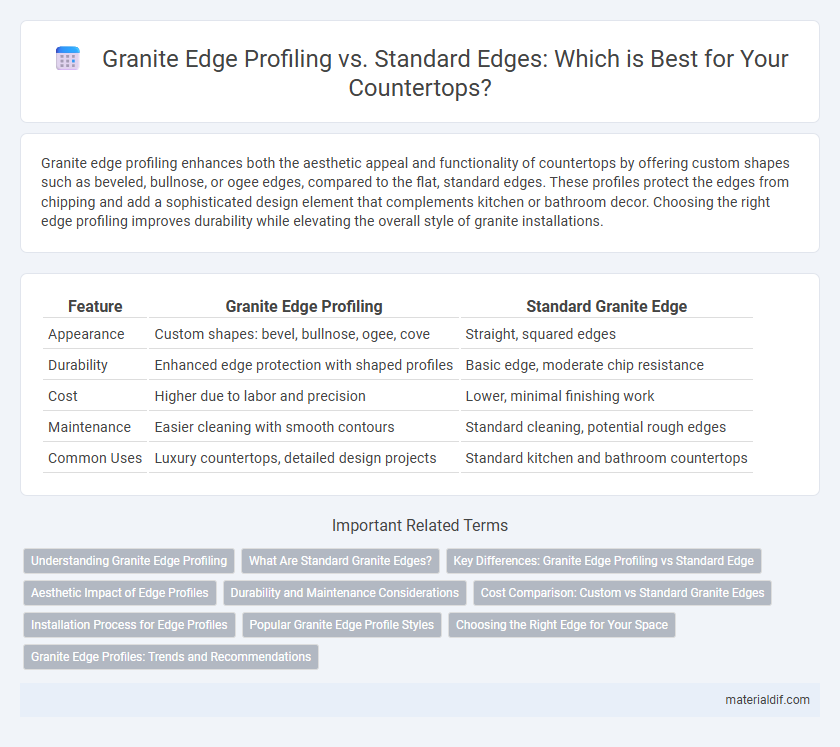Granite edge profiling enhances both the aesthetic appeal and functionality of countertops by offering custom shapes such as beveled, bullnose, or ogee edges, compared to the flat, standard edges. These profiles protect the edges from chipping and add a sophisticated design element that complements kitchen or bathroom decor. Choosing the right edge profiling improves durability while elevating the overall style of granite installations.
Table of Comparison
| Feature | Granite Edge Profiling | Standard Granite Edge |
|---|---|---|
| Appearance | Custom shapes: bevel, bullnose, ogee, cove | Straight, squared edges |
| Durability | Enhanced edge protection with shaped profiles | Basic edge, moderate chip resistance |
| Cost | Higher due to labor and precision | Lower, minimal finishing work |
| Maintenance | Easier cleaning with smooth contours | Standard cleaning, potential rough edges |
| Common Uses | Luxury countertops, detailed design projects | Standard kitchen and bathroom countertops |
Understanding Granite Edge Profiling
Granite edge profiling enhances both the aesthetics and functionality of countertops by shaping the raw granite edges into various designs such as bullnose, bevel, or ogee, which standard edges lack. This detailed process not only provides a polished and refined look but also improves safety by smoothing sharp corners and preventing chipping. Understanding granite edge profiling is essential for homeowners seeking customized, durable, and visually appealing surfaces that complement their interior design.
What Are Standard Granite Edges?
Standard granite edges refer to the basic finishes applied to the perimeter of granite countertops, including popular styles like eased, beveled, and bullnose edges. These edges provide a clean, functional appearance while maintaining durability and ease of maintenance. Standard edges are typically more cost-effective compared to custom or intricate profiles, making them a practical choice for many residential and commercial installations.
Key Differences: Granite Edge Profiling vs Standard Edge
Granite edge profiling involves shaping and finishing the stone's edges into various designs such as beveled, bullnose, or ogee, enhancing both aesthetics and safety. Standard edge on granite typically features a basic, straight cut with minimal shaping, providing a simpler and more cost-effective finish. The key differences lie in design complexity, customization options, and the resulting visual appeal while impacting price and installation time.
Aesthetic Impact of Edge Profiles
Granite edge profiling significantly enhances the aesthetic appeal by offering varied shapes such as bullnose, bevel, and ogee, which add depth and character to countertops compared to standard flat edges. Custom edge profiles create a more refined and tailored look, elevating the visual impact and complementing diverse interior design styles. The choice of edge profile can transform the overall ambiance, making granite surfaces a focal point in kitchens and bathrooms.
Durability and Maintenance Considerations
Granite edge profiling enhances durability by providing thicker and more reinforced edges that resist chipping and wear better than standard edges. Maintenance requirements for granite with custom edge profiles are generally lower due to the edge's robust design, reducing the need for frequent repairs or refinishing. Standard granite edges, while more affordable, are prone to damage from heavy use and may require regular upkeep to maintain their appearance and structural integrity.
Cost Comparison: Custom vs Standard Granite Edges
Custom granite edge profiling typically incurs higher costs due to increased labor and specialized machinery required for intricate designs, whereas standard granite edges are more cost-effective owing to streamlined production and less fabrication time. Standard edges such as eased, beveled, or bullnose offer affordability by minimizing complex cutting and finishing processes. Investing in custom edges increases overall expenses but adds unique aesthetic value and enhances property appeal, which can justify the premium for high-end remodeling projects.
Installation Process for Edge Profiles
Granite edge profiling requires precise cutting and shaping using specialized routers to create smooth, decorative finishes compared to the simpler, straight cuts of standard edges, impacting installation time. The installation process for granite edge profiles necessitates skilled craftsmanship to ensure seamless joins and accurate polishing, which can extend project duration and cost. Standard edge installations are typically quicker and more straightforward, often involving basic grinding and sealing without the need for advanced machinery or extensive finishing techniques.
Popular Granite Edge Profile Styles
Granite edge profiling enhances both the aesthetic and functionality of countertops, with popular styles including eased, bullnose, ogee, and bevel edges. Eased edges provide a clean, modern look with slight rounding for safety, while bullnose edges are fully rounded, offering a softer, traditional appearance. Ogee edges create an elegant, intricate design through S-shaped curves, and bevel edges introduce a sleek, angled finish that complements contemporary granite installations.
Choosing the Right Edge for Your Space
Granite edge profiling enhances both aesthetics and functionality, offering options like beveled, bullnose, and ogee edges that complement various design styles. Standard edges, typically straight or slightly rounded, provide a clean and classic look suitable for minimalist spaces or high-traffic areas. Selecting the right edge depends on your desired visual impact, maintenance preferences, and the overall style of your kitchen or bathroom.
Granite Edge Profiles: Trends and Recommendations
Granite edge profiling trends reveal a shift toward more intricate designs like ogee, bullnose, and beveled edges, enhancing both aesthetics and functionality compared to standard edges. Customized granite edge profiles offer improved durability and resistance to chipping, making them ideal for high-traffic kitchen and bathroom surfaces. Industry recommendations emphasize selecting edge profiles that complement the overall design while ensuring maintenance ease and long-term performance.
Granite Edge Profiling vs Standard Edge Infographic

 materialdif.com
materialdif.com